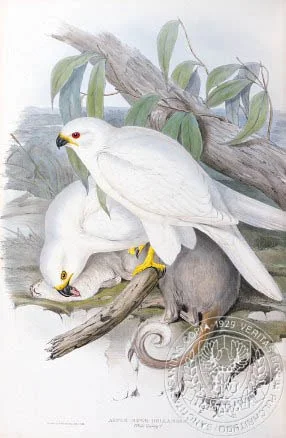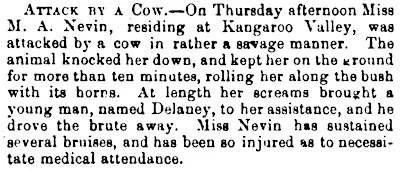There are several reprints of a particular photograph of empty streets and the penitentiary at the Port Arthur prison site which was taken in the 19th century by an unknown photographer, possibly Thomas Nevin and Samuel Clifford on government business in the mid 1870s, or Henry Hall Baily and Alfred Winter accompanying tourists to the derelict prison between 1878 and 1880. It may have been John (Joshua) Anson's original photograph, taken as late as 1888 when it was published in scenic albums by the Anson Bros in 1889. The point here is this: the original photograph has a different title from the one printed later in scenic albums; it has no pencilled inscription on the lower right -hand corner mentioning "A. H. Boyd"; it is not a stereograph; and as a viewer, you can see that there are no people in the photograph. This is a photograph of buildings: it is not a photograph of a man in prison clothing.
 State library of NSW
Port Arthur, Graphic Materials, PXA 609/30-55
Beattie, J. W. (John Watt) 1859-1930
Inscription on recto: "Penitentiary, Port Arthur, Anson Hobart 119?"
Ref: 025320016h
State library of NSW
Port Arthur, Graphic Materials, PXA 609/30-55
Beattie, J. W. (John Watt) 1859-1930
Inscription on recto: "Penitentiary, Port Arthur, Anson Hobart 119?"
Ref: 025320016h
This is the single original photograph printed by John or Joshua Anson ca. 1888. The Anson Bros (Henry and Joshua) subsequently printed this image with different borders, and included it in various scenic albums in the name of tourism. The
Mercury of 20th June 1889 announced the publication of the first edition of one of their albums containing a reprint of this photograph, titled
Port Arthur Past and Present , emphasising that "
the 'past' portion of the views has been obtained from negatives purchased by the publishers". In other words, this photograph was probably reproduced from an earlier photographer's negative. Given that the stock of negatives from the studios of Thomas Nevin(1876/1888) and Samuel Clifford (1878) were acquired by the Ansons before this album was published, its provenance was most likely from the "
past portion" purchased by the Ansons.
 TRANSCRIPT
TRANSCRIPT
PORT ARTHUR PAST AND PRESENT.-We have to acknowledge receipt from Messrs. Anson Bros, of a copy of this photographic work which has just been issued from their studio. The historical interests which are attached to the views should alone create a large demand for the book,, but aside from this, as a work of photographic excellence, it is entitled to a very high place. The "past" portion of the views has been obtained from negatives purchased by the publishers, and gives the possessor of the work a thorough knowledge of' the chief features of the old penal settlement. The views in the present issue number 12, and are as follow:-Port Arthur in 1888, During Convict Occupation, Dead Island, Penitentiary during occupation, Interior of Penitentiary, Hall Model Prison, Chapel, Model Prison, General View of Model Prison, Invalid Depot, Dead Island from Point Puer Cliffs, Point Puer, Coast view. The album has been got up In really first-class style, and reflects much credit on Messrs. Anson Bros.' taste and enterprise.
Source: http://nla.gov.au/nla.news-page823472
The Anson Albums
The State Library of NSW holds this album and at least three others in which the same image of the Port Arthur buildings appears. However, with the focus now on the questionable pencilled inscription on one of the photographs, the library's catalogue notes have cross-references to the image in a plethora of entries. For example, this catalogue uses the call no: DL PXX 64:
Title Port Arthur Past & Present / by Anson Bros.
Creator Anson Brothers
Date of Work 1820; 1845; 1878-1895
Call Number DL PXX 64
Physical Description Albums : 1 album (13 albumen photoprints, 4 printed items , one with MSS annotations) ; 36.3 x 48.5 cm.
Signatures / Inscriptions
Title taken from spine.
"Settlement of Port Arthur (Penal Settlement) Past and Present, Photographed by Anson Bros., Wellington Bridge, Hobart" -- title page.
General Note
Description taken from title printed on the mount; 8 images have a slightly varying title printed along lower edge of photograph
This album holds some prints that are housed in Settlement of Port Arthur (Penal Settlement), Past and Present, / Photographed by Anson Bros ... (PXD 512 and PXD 513).
Two further albums Settlement of Port Arthur (penal settlement), past and present / photographed by Anson Bros. are held in the State Reference Library collection at TX00284 and TX00285.
In all, there are at least six albums of Tasmanian scenes at the State Library of NSW which have been attributed to the Anson Bros. located at these call numbers: PXD 511, PXD 512, PXD 513, PXD 516. The album which bears the fake inscription - at PXD 511 - is currently listed online with notes about John Watt Beattie yet there is no mention here of Boyd, just in the contents list with this description. Note that it does NOT say "taken by A.H. Boyd":
10. Port Arthur during convict occupation. Enlargement from a stereoscopic view by A.H. Boyd [Commandant, Port Arthur l87l-74]
Title
Views in Tasmania, Vol. II, ca. 1885-1894 / Anson Brothers
Creator Anson Brothers
Level of Description
Collection
Date of Work ca. 1885-1894
Type of Material
Graphic Materials
Call NumberPXD 511
Physical Description1 album (38 photographs): 32 albumen, 6 carbon; various sizes
Administrative / Biographical Note
J.W. Beattie was employed at Anson Brothers, 1882-1891. In 1891, Beattie purchased the studio and its stock, later printing under his own name.SourceTransferred from Printed Book collection F986/3A2, December 1984.Copying ConditionsOut of copyright - Created before 1955
Date Note
Undated. Dated by comparison with prints in accompanying volume.Signatures / InscriptionsSome prints are signed 'Anson Brothers'. Each photograph is titled on print or in pencil on mount.
This is the album at PXD 513 in which the original image is mounted within a crossed red frame:

 Ansons Bros. photographic album, Port Arthur Past and Present (1889)
State Library of NSW. Call No: PXD 513
Photos copyright KLW NFC 2009
Ansons Bros. photographic album, Port Arthur Past and Present (1889)
State Library of NSW. Call No: PXD 513
Photos copyright KLW NFC 2009
 The same title inscription on the image as above, inside the border
Red crossed border, and below the border, the Anson Bros (plural) and a more elaborate title:
"Anson Bros. Hobart.
The Penitentiary Port Arthur during Convict Occupation".
The same title inscription on the image as above, inside the border
Red crossed border, and below the border, the Anson Bros (plural) and a more elaborate title:
"Anson Bros. Hobart.
The Penitentiary Port Arthur during Convict Occupation".
Photos copyright © KLW NFC 2009 ARR
But only ONE of those prints of the photograph of Port Arthur buildings has this pencilled inscription written in a modern hand -
"Enlargement from a stereoscopic view by A H Boyd Esq."
It is catalogued at
PXD512/ f6. with this misleading and erroneous statement:
The photographs are not dated.
The earliest date is that of the Penitentiary (no.6) taken by A.H. Boyd, Camp Commandant 1871-1874. (see Views in Tasmania, Vol. II, ca. 1885-1894 / Anson Brothers. PXD 511/no. 10 ‘Port Arthur during convict occupation’)
The latest date is the end of the Anson Bros. partnership.
Reference:
The mechanical eye in Australia : photography 1841-1900 / Alan Davies & Peter Stanbury ; with assistance from Con Tanre. Melbourne : Oxford University Press, 1985.
This note about A. H. Boyd has recently appeared in the SLNSW catalogue entries (post 2010) with a forceful phrase "
taken by A.H. Boyd" in an attempt to cover-up the gullibility of conventional photohistorians in publishing nothing more than a rumour spread by Boyd's descendants in the 1990s that he was "the author" of the extant "
Convict portraits, Port Arthur 1874" collection of prisoner mugshots held at the National Library of Australia and elsewhere. The Anson album photograph of the Port Arthur penitentiary buildings and empty streets is not a mounted carte-de-visite photograph of a man in prison clothing, yet the curator of photographs at the State Library of NSW, Alan Davies, has proposed it is sufficient evidence to warrant a claim that A.H. Boyd was a photographer where no evidence is to be found anywhere, and to extend that claim to a proposition that Boyd was also the photographer of the "bulk" of the 300 extant prisoner cartes, despite all the available historical evidence of attribution to Thomas J. Nevin. As recently as August 2009, Alan Davies maintained that proposition, which is founded in the cliched equation "Tasmania + convicts = Port Arthur" in an email to this weblog, extracts of which are quoted here:
... the attribution of the several hundred portraits known as the convict photographs is unresolved ... please see Anson Bros Views in Tasmania Vol II. (PXD511/ f10) The view looking south from the slope opposite the Penitentiary is inscribed on the mount in a contemporary hand "Enlargement from a stereoscopic view by A H Boyd Esq." This view also appears in Anson Bros., Settlement of Port Arthur (Penal Settlement ) Past and Present. We have two copies (PXD512 and PXD513) and the references to the Boyd image in both are PXD 512/f4 and PXD 513/f6. Comparison of this photograph with the images in the Anson/Beattie collection titled Port Arthur during occupation , leads to the conclusion that they may also be by Boyd. It would seem that like many Tasmanian photographers, Boyd s work was subsumed by the Anson/Beattie archive, leading to later problems of attribution. (Alan Davies, email to this weblog August 2009)
This is the print in question: the same photograph and the same image as the two above, in a different Anson album and with the pencilled inscription about A. H. Boyd which carries all the weight of a rumour and none of the substance of facts.
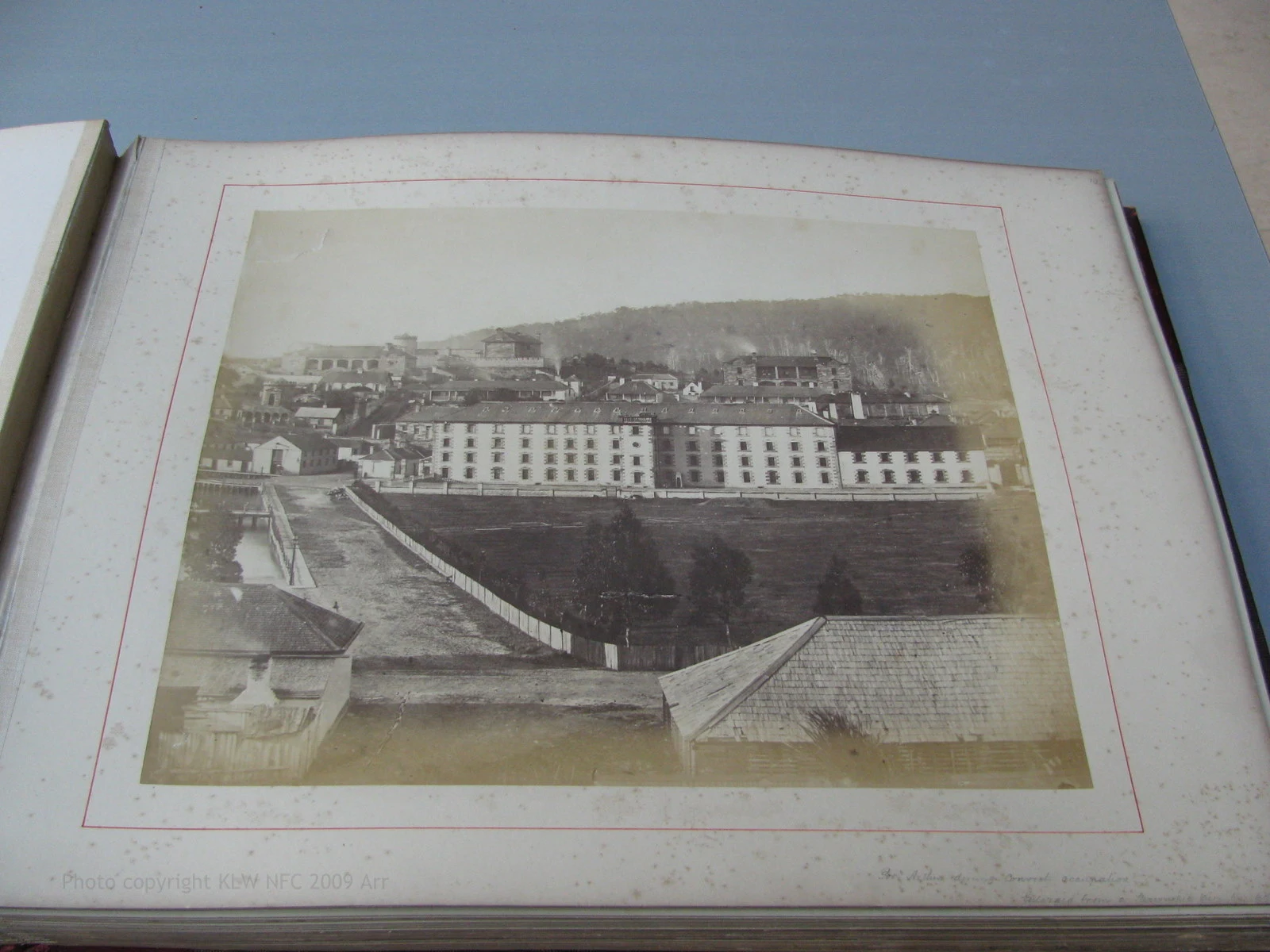 State Library of NSW
Anson Bros Views in Tasmania Vol II. (PXD511/ f10)
Photos © KLW NFC 2009 Arr
This is it
State Library of NSW
Anson Bros Views in Tasmania Vol II. (PXD511/ f10)
Photos © KLW NFC 2009 Arr
This is it: the reprint in
Anson Bros Views in Tasmania Vol II. (PXD511/ f10) with the pencilled inscription, "
Enlargement from a stereoscopic view by A H Boyd Esq." This second volume appears to have been accredited to the Ansons on accession at the SLNSW by a process of deduction and reference to the more elaborately framed versions of the same images in the first volume of
Views in Tasmania. The descriptions of the images therefore in this second volume were attributed by staff at the SLNSW in 1964, based on assumptions and cross-referencing to Vol. 1 and to the other prints bearing Ansons' name inside the frames of the other three albums at PXD 510, 513 and 514. A pencilled note on one of the volumes states:
2 Vols:
"The first photo gives a scene taken in 1894 & this, doubtless, is the approximate date of the whole series of photos in these 2 Vols."
How elaborate all this cross-referencing has become since our focus has been to examine the authenticity of the pencilled note about A.H. Boyd. See this related article:
Improprieties; A H Boyd & the Parasitic Attribution
Fraudulent Pretensions
This ONE print, an enlargement of a (supposed) stereograph held at the Mitchell Library, SLNSW, which the curator of photographs maintains is evidence of Boyd's photographic talent, was not even noted as an image by Boyd in the SLNSW's catalogue entry for the album in which it appears, evidenced by this webshot taken in 2009:
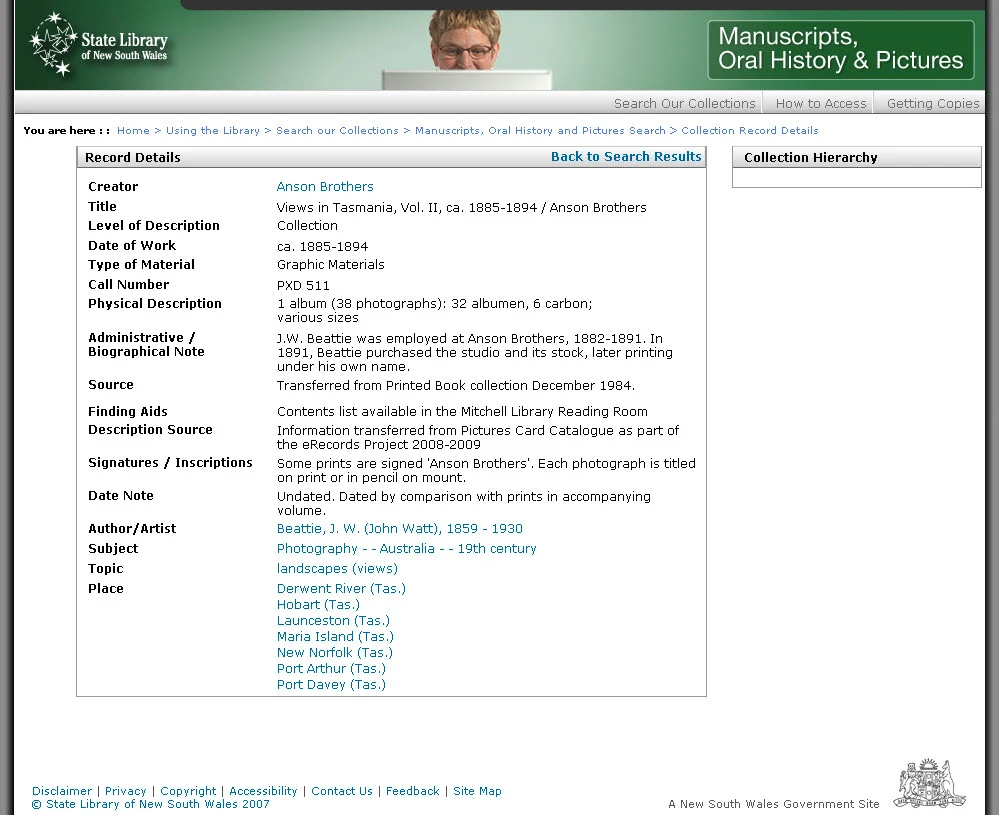 Anson Bros Views in Tasmania Vol II.(PXD511)
Anson Bros Views in Tasmania Vol II.(PXD511)
The album itself was bound in red leather by the Royal Museum Scotland, owned by Capt A.W.F. Fuller in 1946, donated by his wife and accessioned by the State Library of NSW in 1964.

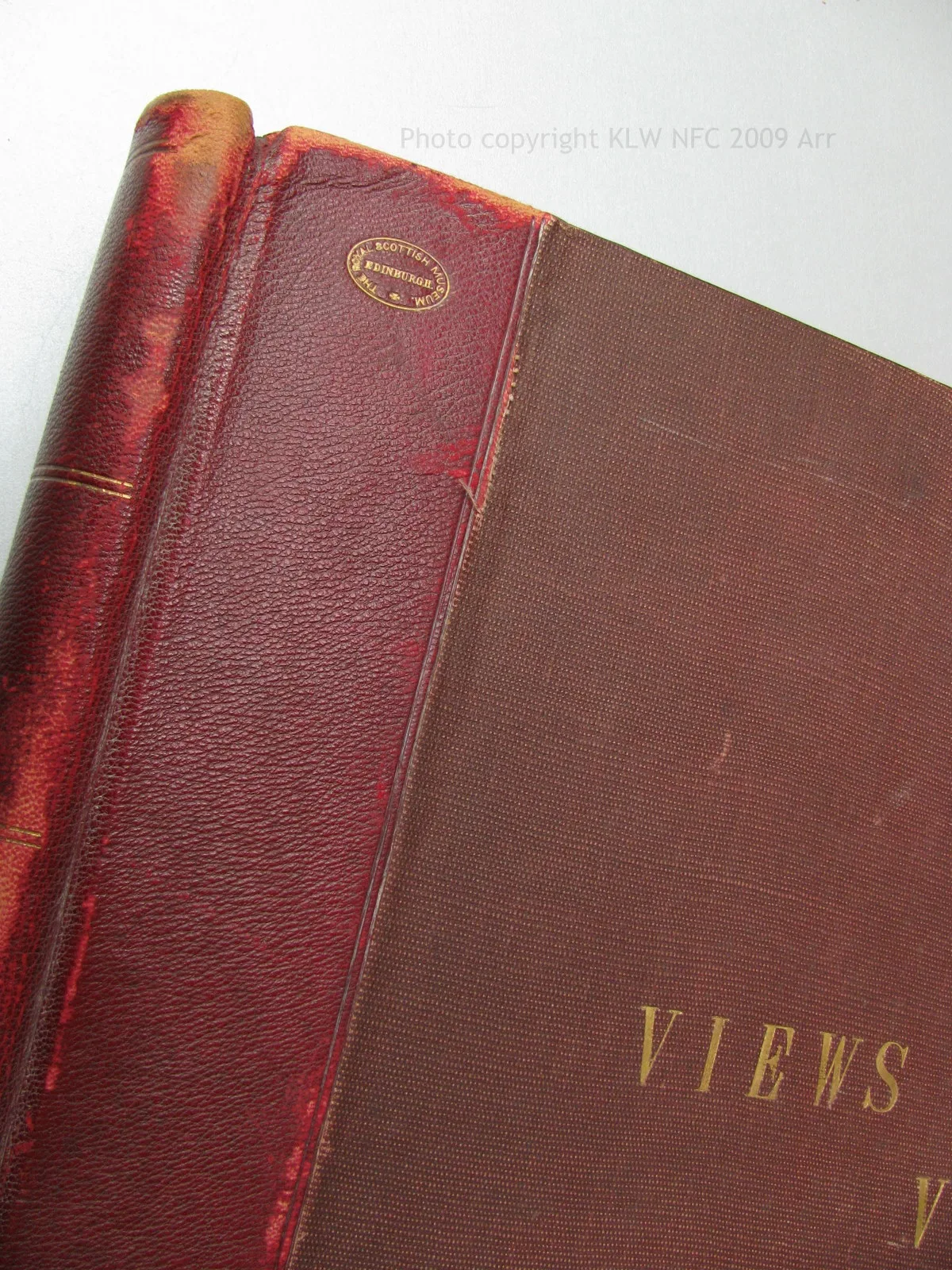 Vol. 2, Album bound in Scotland, inside cover with dates
Vol. 2, Album bound in Scotland, inside cover with dates
Photos copyright KLW NFC 2009 Arr
Below is the image used as the basis of the claim to be by A.H. Boyd. It is No. 10 in this album, (PXD511/ f10) and has a pencilled note underneath, "
Enlargement from a stereoscopic view by A H Boyd Esq."
 None
None of the other prints in this album, Vol. 2, has a similar note or additional inscription, and this single fact raises questions and suspicions as to why it was added. In addition, the note about Boyd is so indistinct, not even a magnifying glass renders it visible, e.g.





 Mitchell Library, SLNSW
Views in Tasmania, Vol. II, ca. 1885-1894 / Anson Brothers.
PXD 511/no. 10 ‘Port Arthur during convict occupation’
Taken at the SLNSW
Photos copyright © KLW NFC 2009 ARR
Mitchell Library, SLNSW
Views in Tasmania, Vol. II, ca. 1885-1894 / Anson Brothers.
PXD 511/no. 10 ‘Port Arthur during convict occupation’
Taken at the SLNSW
Photos copyright © KLW NFC 2009 ARR
According to Alan Davies, curator of photographs at the SLNSW, co-author of the 1985 publication
The Mechanical Eye in Australia, and one of several people who received a letter from Chris Long ca 1984 suggesting Boyd was a photographer (despite no evidence), this ONE enlargement dated 1894 by the SLNSW, reprinted from an original stereograph (?) which is likely to be an original by Nevin or Clifford ca. 1874 is THE ONLY image underpinning the vapid claim that Boyd photographed prisoners.
The stereograph (?) is not even a photograph of a prisoner. It is an enlarged reprint by the Anson Bros of an image of empty streets and the Port Arthur penitentiary which is also held at the Archives Office of Tasmania, dated 1880 and unattributed. The same image appears in an Anson album held at the State Library of Tasmania, dated ca. 1875, and may have been taken by H.H. Baily (see PHILADELPHIA Exhibition notice below):

This is the same image at the Archives Office of Tasmania, unattributed and dated 1880:

The image was reprinted in another album by the Ansons, held at the State Library of Tasmania, and dated ca. 1875, per this catalogue entry:

The aggressive promotion of this notion - that Civil Commandant A. H. Boyd was not only a photographer, but THE photographer of the extant 300 Tasmanian prisoners' carte-de-visite photographs - is one of the fictions created for the commercial promotion of the Port Arthur Historic Site as Tasmania's premier tourist destination. The notion, as demonstrated, has no basis in fact. If the pencilled note under the image attributed to Boyd in the Anson Album at the SLNSW (PXD 511/f10) existed prior to 1983, why had Chris Long NOT known about it when researching the prisoner cartes in Tasmania and duly referenced it in notes left there, and which were then forwarded to the NLA in 1982 when their prisoner cartes were being accessioned? Chris Long had certainly not heard of any so-called "Port Arthur photographer" by the name of A. H. Boyd, amateur or otherwise, when he submitted a draft copy of his list of early Tasmanian photographers to Dan Sprod, former Chief Librarian at the National Library of Australia (17th July 1983, NLA Dan Sprod MS 8429 Box 1): T.J. Nevin's name on that list, however, is asterisked "
to indicate the photographer's work survives in reasonable quantities." Chris Long blamed difficulties with his editor Gillian Winter (TMAG, 1995) and rumours spread by A. H. Boyd's descendants for publishing this furphy.
It would seem that this pencilled note underneath the image at the SLNSW was written sometime between 1984 and 1992, when Joan Kerr et al publicly refuted Chris Long's hypothesis about Boyd in their entry on Thomas J. Nevin (page 568,
The Dictionary of Australian Artists: painters, sketchers, photographers and engravers to 1870, (Melbourne: Oxford University Press). Someone then pencilled the note -
"Enlargement from a stereoscopic view by A H Boyd Esq."
- underneath the reprint to support Chris Long and his "belief" in Boyd based on
(a) a 1930s children's fictional story by a Boyd descendant
(b) rumours spread by Boyd's descendants in the 1990s
(b) glass plates listed as cargo for Port Arthur in July 1873.
Fraudulent pretensions beget fraudulent pretensions, it seems. Or the case may be that the Boyd apologists have mistaken his
ownership of a print for his
authorship. The SLNSW holds another document with Boyd's name scribbled on the cover, a legal document by Rocher published in the 1850s on prison discipline which Boyd kept in his office.
Genesis of the A.H. Boyd Misattribution
A.H. Boyd (1827-1891) was a Hobart-born accountant appointed to government service in 1848. He served at the Port Arthur prison as Civil Commandant from 1871 until his forced resignation in December 1873 under allegations of corruption and nepotism directed at his brother-in-law Attorney-General W.R. Giblin in Parliament (
Walch's Tasmanian Almanac 1873; Australian Dictionary of Biography online;
The Mercury, July 1873 ). He married Giblin's sister Henrietta in 1871. His subsequent appointments were in the administration of welfare depots. He was acting as coroner at Franklin, 28 miles south of Hobart shortly before his death (
Walch's Tasmanian Almanac 1889, p.319).
Boyd's obituary published in
The Mercury, 24th November 1891, made no mention, of course, of photography for the simple and very real reason that he was not a photographer.
In 1979, Margaret Glover published a paper about Port Arthur titled
Some Port Arthur Experiments (In:
T.H.R.A. Papers and Proceedings, vol. 26 no. 2, Dec. 1979, pp. 132-143). Glover does NOT mention or reference a children's story in script form (dated 1930), written by Edith Mary Hall nee Giblin, daughter of Attorney-General W.R. Giblin and niece of A.H. Boyd, yet this children's fiction about the narrator's childhood visits to Port Arthur and posing for a photograph is referenced as a factual reminiscence of Port Arthur by
Warwick Reeder 1995.This single memory, of a child aged less than five years old, delivered as a talk in 1930, and reprised by Warwick Reeder, citing Chris Long in 1995, is the kernel and genesis of the myth of A.H. Boyd as an amateur photographer of convicts.
For reasons best known to amateur photo historian Chris Long and his editor Gillian Winter in the publication
Tasmanian Photographers 1840-1940: A Directory (1995, Tasmanian Museum and Art Gallery), their supposed perusal of a document (Tasmanian Papers 320, SLNSW ) showing that a cargo of 288 photographic plates was intended for delivery to government stores at Port Arthur in July 1873, suggested to them that this same Commandant at Port Arthur, A. H. Boyd, had personally taken photographs of the prisoners there, the same photographs now extant in public collections at the NLA, the TMAG, and the QVMAG etc, which have a published and curatorial attribution to Thomas J. Nevin (1977, 1978, 1984, 1992, 1995, 2000, 2009, 2010). Nevin's stamp bearing the government Royal Arms insignia on several cartes in public collections was sighted and validated by Long, despite his idle suggestions about Boyd.
Illogical as it now seems, this implausible idea and impossible scenario about Boyd, or
" belief" as Long phrases it (p. 36, TMAG 1995), had a certain appeal for photo historians in the late 20th century who wished to mobilise the Foucauldian tropes of surveillance by the powerful of the powerless within postmodernist discourse (
Reeder 1995,
Ennis 2000, Crombie 2004).
There was one problem for Chris Long et al, namely the discrepancy between July 1873 when the plates supposedly arrived at Port Arthur and the date of "1874" which appears in the handwritten transcription "
Taken at Port Arthur, 1874" across the verso of many of these prisoners' images, an inscription most likely devised by Beattie to excite interest in his displays of convictaria at his museum in Hobart. No discussion ensued that countenanced an error concerning the date 1874, made perhaps much later by commercial photographers Beattie or Searle reprinting these mugshots in the 1900s for tourists, or by the archivists Ms Wayn and Peter Eldershaw at the AOT 1920s, 1950s or even later museum and library workers at the QVMAG from the 1960s-1980s who numbered them again and dispersed the duplicates to libraries, museums and heritage sites (NLA, TMAG, ArchivesTas, Port Arthur HS etc).
 Harriet's way bill, 30th July 1873.
Cargo of 288 photographic glasses listed for Port Arthur
Tasmanian Papers Ref: 320, SLNSW
Harriet's way bill, 30th July 1873.
Cargo of 288 photographic glasses listed for Port Arthur
Tasmanian Papers Ref: 320, SLNSW
To account for the discrepancy between
July 1873, the date of the schooner
Harriet's way bill listing of 288 photographic glasses, and
1874, Chris Long et al decided that the plates were used by Boyd personally, and that they were printed in 1874 by Nevin,
at least six months later. An unscientific supposition about wet and dry collodion processes was used as collateral. No cross-referencing was made to the police records of individual convicts, no research was conducted on Nevin's professional contracts apart from a few details derived from Kerr (ed, 1992), no commercial photographer other than Nevin was considered, and no evidence given that could validate the proposition of Boyd ever having held a camera, let alone the training, skills and equipment required to use the plates.
The insistence that the prisoners were photographed at Port Arthur by Boyd was grounded in Long's belief that the wet plates needed to be processed in situ; yet Nevin's partner
Samuel Clifford was well-known for his dry-plate expertise in the 1860s and so was Nevin. In any event, any photograph taken at Port Arthur by these two photographers, whether of landscapes, buildings, prisoners and prison officials, was developed and printed within their own extensively equipped Hobart-based commercial studios. The impracticality of photographing prisoners en masse at Port Arthur after July 1873, the date when the plates supposedly arrived, would have been obvious to the photographers because the prisoners were already being transferred to the Hobart Gaol, a process begun by 1871. Sixty prisoners had already been returned to Hobart when Attorney-General Giblin tabled his report in May 1873.
Another obvious question which Chris Long and his editor never countenanced was this: what happened to the police photographs taken in , say 1875, or 1876, or the other 2500 negatives of prisoners taken by Nevin during his service as police photographer. The 200 extant photographs they wish to bless with an aethete's gaze and touch are in fact randomly salvaged estrays from that much larger corpus commissioned by the Hobart City Council's Land and Survey Dept, the Municipal Police Office, and the Hobart Gaol from Nevin's first contract in January 1873 to his last ca. 1886.
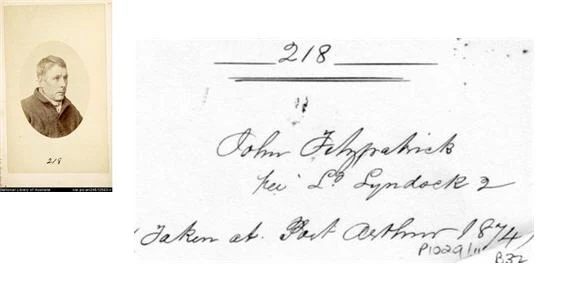 "Taken at Port Arthur 1874"
"Taken at Port Arthur 1874"
Verso of convict carte (inserted) at the NLA.
A. H. Boyd had no reputation in his own lifetime as a photographer, none subsequently, and no works by him are extant, yet he suddenly entered photohistory as an “artist” in 1995 due largely to Warwick Reeder’s reprisal of a children’s story written by a Boyd family member, and a cargo list.Thomas Nevin, well-known within his lifetime as a contractual commercial photographer, civil servant, and special constable with the Municipal and Territorial Police, and with a sizeable legacy dating from the 1860s held in State, National and private collections, was effectively dismissed as a "copyist" by Chris Long. Authoritative commentators who were aware of the problem ensured Chris Long was named as someone in error on this matter when Nevin's biographical details were published in 1992 ( Willis, Kerr, Stilwell, Neville, etc).
Chris Long's "belief" in Boyd was a very curious manipulation of facts, a vague and sudden photographer attribution to a person by the name of A. H. Boyd whose descendant Mr. I. Boyd had donated a photograph of a youthful Boyd taken by Charles Woolley in the 1860s to the Tasmanian Museum and Art Gallery in 1978. This single photograph was used to buttress the whole collection of prisoners' photographs with Boyd's name as the photographer based on nothing other than a descendant's whim. Even more strange is the fact that the State Library of Tasmania's considerable holdings of photographs dated between 1871 and 1873 were taken by Samuel Clifford around Port Arthur: the buildings, the visitors, the officials etc etc, yet Clifford's name never entered the mix. Furthermore, these photographs of Port Arthur mounted with Clifford's stamp cannot be accurately dated, since Clifford advertised in
The Mercury, January 17th, 1876, that he had acquired the
interest in Nevin's commercial negatives and would reprint them for Nevin's patrons on request.
If a cargo of glass plates arrived at Port Arthur in July 1873, they may have been used by Clifford, Nevin's mentor and senior partner during his stereograph phase from the late 1860s, to mid 1870s, yet this easily accessible information and obvious use was not cited by Chris Long et al. The information made available by Tasmania's specialist in photo history at the State Library of Tasmania, G.T. Stilwell, was also ignored. Less than a year after the first exhibition of Nevin's convicts photos at the QVMAG in 1977, Stilwell had located government tenders for Nevin's commission with the Municipal Police Office, among others from the Hobart City Council Lands and Survey Dept for Alfred Winter's commission to photograph the city's buildings, and Henry Hall's Baily commission to photograph notable citizens.
The London International Exhibition
Tasmanian photographers exhibited at the London International Exhibition 1873. The only records pertaining to the Tasmanian government's expenses of photographic materials in the years 1873-1874 are those which paid the UK Secretary of State's custom tariff on behalf of the London Ethnological Society 's interest in acquiring photographs for the 1873 exhibition:
The
Journals of the House of Assembly for June 1873 documented the Colonial Treasury's expenditure on photographs:


On June 23rd, 1873 the Colonial Treasurer paid 14/8 shillings for "
Expenses in London clearing, &c. Case of Photographs for Secretary of State ...". This was the additional expense for sending the "
Photographs of Aborigines for Ethnological Society ... 5.0.0 " i.e. five pounds to London.
The photographs of Aborigines were reproductions for the Ethnological Society (London) of those taken by (Bishop) Francis Russell Nixon in the 1850s, Henry Frith, and Charles A. Woolley ca. 1866. Bishop Nixon was a permanent resident in London by 1865, never to return to Tasmania. The case of photographs cleared in London
for the British Secretary of State were
not photographs of Tasmanian prisoners; in addition to the photographs of Aborigines there were photographs - reprinted - taken at the request of Queen Victoria of Tasmanian children, of local architecture, and of landscapes following the visit of her son the Duke of Edinburgh in 1868 to Charles Woolley's studio. These too were intended for the London International Exhibition, 1873.
If a cargo of 288 photographic glasses actually arrived in government stores at Port Arthur in July 1873 and were used to photograph the prisoners there for official prison records, as Chris Long et al wanted to believe, and had therefore been bought by the government, who supplied and paid for them? Not the Colonial Treasury. The case of photographs (used plates or prints)
for the British Secretary of State were cleared in June 1873. They were arriving in London, not departing. The date of 288 plates listed as cargo for Port Arthur was on 30th July 1873, less than
a month after the Colonial Treasury's tabling of the government's photographic expenses. Those glass plates could not have been the same case of photographs cleared in London for exhibition in London.
If Boyd had requested (from which supplier?) 288 plates destined to government stores at Port Arthur, the Colonial Treasury report (above) would show such detail, but it shows no items of expenditure for photographs sent to Port Arthur 1873, although the general expenditure on Boyd and the Port Arthur site was considerable. By June and July 1873 the Parliament was questioning W. R. Giblin the Attorney-General about
the corrupt practices of Boyd, Giblin's brother-in-law (
Mercury, July 1873), and the vast amounts being spent on the penal settlement, including Boyd's huge salary, all reasons among others raised about inhumane practices by Drs Crowther and Coverdale to close down the prison there as soon as the inmates could be relocated to Hobart (the "Mainland"). On July 19th, 1873,
The Mercury reported these men's concerns:
... one great reason why Port Arthur should be broken up was the cruel wrong done by sending men young in crime to herd with habitual criminals ... The point he wished to direct the attention of the House to was ... that a great wrong and injustice had been done by the late Government in order to perpetuate an establishment of that kind that short-sentenced men had been sent there ... July 19, Mercury 1873
A year and a half later, in 1876, the Colonial Secretary ordered all documents pertaining to the Commissariat's stores be destroyed (AOT), a measure to cover up corruption which underscored the waste of government funds. However, Port Arthur records were offered at auction in 1879 in Hobart and Melbourne in the face of public protest and a belief the government had ordered their destruction by 1876 (Source: Alison Alexander,
Tasmania's Convicts 2010). Many later ID prisoner photos were burnt along with other prison and convict records during the Joseph Lyons terms of government.
Samuel Clifford, Thomas J. Nevin and H. H. Baily
Samuel Clifford's photographs of the Port Arthur site, its officials and surrounds between 1871 and 1873 were commercially produced cartes and stereographs bearing his impress on the mount (SLTas), including the series depicting Governor Du Cane and his vice-regal guests. However, no association with the extant prisoner ID photographs and Clifford's name can be made, apart from Clifford's partnership with Thomas Nevin in the late 1860s to the late 1870s of stereographs and studio portraits of private patrons (
The Mercury 1876; QVMAG; TMAG; Private Collections).
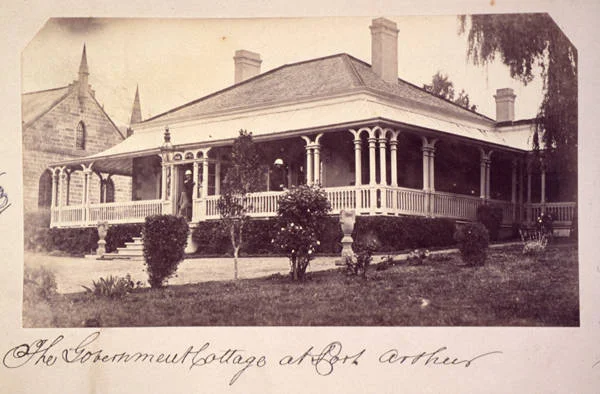 Attributed to Samuel Clifford
The Government Cottage, Port Arthur,
Photo dated 1873
State Library of Tasmania
Attributed to Samuel Clifford
The Government Cottage, Port Arthur,
Photo dated 1873
State Library of Tasmania
Another close associate of Nevin's was commercial photographer Henry Hall Baily (their companionship was mentioned in
The Mercury, December 4, 1880). Baily was a victim of theft by his apprentice, Joshua Anson.
The Mercury's account of the trial and conviction of Joshua Anson, in June and July 1877 for theft and serious fraud, detailed the case. Joshua Anson, still in his teens in 1872-74, ordered expensive cameras, lenses, glass plates, albums, mounts from Melbourne and Paris, and sundries from London through the firms of Websters, Weavers the chemists, and Walch's Stationers, Hobart on Baily's account and without Baily's knowledge. He kept the loot at his mother's home where it was discovered by Detective Connor. Aged 22 in 1877, Joshua Anson was finally arrested after years of suspicions held by Baily, and imprisoned for two years. Chief Justice Francis Smith stated in his summary that the seriousness and scale of the theft warranted a sentence of 14 years, and leniency was granted only on account of Anson's youth. Anson's plea was to be kept apart from the prisoners on incarceration, because he felt he was above them, though the jury did not agree.
 The Joshua Anson trial
The Mercury, June 9th 1877.
The Joshua Anson trial
The Mercury, June 9th 1877.
The goods stolen were valued at 180 pounds, though their real value was much greater, and included large quantities of glass, negatives, boxes, lenses, mounts, chemicals, and albums by Baily called "Souvenirs of Tasmania." Samuel Clifford who was called as a witness identified several of his stereographs and albums among those which he said he had sold to Anson, and which Anson had reprinted as his own, an offense which the court noted as
fraudulent pretensions.
 The Joshua Anson trial,
The Mercury, July 11th 1877.
The Joshua Anson trial,
The Mercury, July 11th 1877.
Joshua Anson's photographs of Port Arthur were not taken before the 1880s. Thomas Nevin was at the Port Arthur prison site with Alfred Bock during 1866 when Bock sent a telegram to Samuel Clifford to send down more dry plates while photographing prison officials and the state of the buildings. He was there again with Samuel Clifford in 1873 to photograph the evidence of expenditure on renovations to the buildings and other engineering works which A. H. Boyd claimed as expenses, and he was there again in May with the new Surgeon-Commandant of the Port Arthur prison, Dr Coverdale, just weeks after the birth of his second child, Thomas James Nevin jnr. The prisoners at Port Arthur were never photographed by A. H. Boyd for official purposes and for any other purpose because (a) he was not a photographer, (b) the glass plates sent as cargo might never have arrived, or they were used by Clifford to photograph visiting dignitaries in July-August 1873 and (c) studios were set up for the purpose of photographing prisoners at the Hobart Town Hall Police Office next to the cells in the basement, and at the Hobart Gaol Campbell St above the women's quarters and laundry. Eight hundred (800) prisoners had been photographed by Thomas Nevin between 1872 and 1875 alone, and thousands more were photographed by the Nevin brothers in the following decade. Thomas Nevin ceased professional photography in 1888, passing his stock of negatives on to John Watt Beattie at Ansons Bros studios, who reprinted many for display in Beattie's convictaria museum located in Hobart.
The shipment of photographic items which arrived at Port Arthur in August 1873 were duplicates from Nevin's negatives of prisoners taken at the Hobart Gaol, together with details of the prisoners' records held in the central registry of the Police Office at the Hobart Town Hall. The purpose was to check convicts' shipping records with current records held in Hobart for aliases. Many of the men photographed by Nevin gave him an alias. One notable example of at least 40 aliases among those pictured in extant cartes was William Campbell. Nevin accompanied Campbell back to Port Arthur on 8th May 1874 to correlate the police data with the convict transportation records. Campbell was hanged a year later as Job Smith. His other alias was Brodie (see Way Bill below).
Henry Hall Baily was principally a society photographer. His series of more than 100 photographs of notable administrators, including Governor Weld, and prominent businessmen in Tasmania was submitted to exhibitions in Melbourne and Philadelphia.
 Governor Weld 1875-1880
State Library Tasmania
Ref: AUTAS001125883652
Governor Weld 1875-1880
State Library Tasmania
Ref: AUTAS001125883652
This image is unattributed at the State Library of Tasmania. It was the photograph taken by Henry Hall Baily of Governor Weld for exhibition at the Philadelphia Centennial Exhibition, according to the report in
The Mercury, December 1st, 1875:
PHILADELPHIA EXHIBITION. - There are now ready for shipment some further exhibits of our most valuable wools, which have come in since the 23 boxes and two bales were despatched per last Southern Cross. These consist of six fleeces of pure merino wool, hot water washed, from Mr Page, of Ellenthorpe Hall, and three fleeces of pure stud merino rams from the Hon. Donald Cameron, of Forde, which are valued by the owner at £150,and £80 respectively. These, with eight fleeces from Mr. George Taylor, of Milford, have all been presented by the exhibitors to the Museum of the Academy of Natural Sciences in Philadelphia, to which also has been presented, by the Municipal Council of Hobart Town, the large frame of photographs of the public buildings of the city, the large map of Tasmania, and also the bismuth iron and tin ores which received prizes in Melbourne at the recent successful exhibition there. Mr. H. H. Baily's books of Tasmanian views and portraits which received a prize, have been returned to the secretary in this colony, with a request that some of the plates which have been damaged by the inspection of the 240,000 visitors to the exhibition might he replaced by clean plates--a request which Mr. Baily has at once expressed his pleasure to accede to. The first photographic picture in the book is that of His Excellency Mr. Weld, C.M.G., in his gubernatorial uniform; and amongst the hundred other portraits are those of many of our best respected citizens and their beautiful children 'of all ages, the last few pages being occupied with portraits of the American officers who were on 'scientific duty in the Swatara, and who had made themselves so very popular in this colony.
Photographs of the Exhibition Halls and exhibits were commissioned.
See this excerpt from the Philadelphia Centennial Exhibition homepage for an overview.
Expenses incurred by damages to Baily's plates at the Exhibition were eventually underwritten by both the Municipal Council of Hobart and the Colonial Secretary, but the case sent to Port Arthur does not appear to be associated with any official document apart from a simple ship's cargo list.
Just as Baily's public work received official support and funding, Nevin's early police photography from his first prisoner photographs 1871, acceptance of his first tender in 1872, and contracts from early 1873 were funded on commission to the Municipal Police Office and City Corporation, undersigned by the Colonial Government and his solicitor, the Hon. Attorney-General W. R. Giblin. He was issued with Royal Warrants twice: the first was H.R.H Prince Alfred's insignia of three feathers, awarded while working with his partner Robert Smith as the firm Nevin & Smith during the Duke's visit ot Tasmania, 1867-1868; the second with the Lands and Survey Dept, Police Office and Hobart City Council from 1870. Thomas Nevin's appointment in 1876 to full-time civil service as Hall and Office Keeper at the Hobart Town Hall, which housed the Police Office's central registry of prisoner records and photographs, consolidated the confidence of Attorney-General Giblin and Inspector of Police John Swan (whose sister Maria Nairn had leased an acre of land at Kangaroo Valley to Thomas' father John Nevin). His brother Constable John Nevin assumed a central role in the photographic activities at the Hobart Gaol from 1876 through to the mid 1880s while Thomas Nevin continued to serve the Municipal and New Town police as photographer and assistant bailiff.
In almost every instance, the prisoners whose photographs survive today were photographed at the Supreme Court trials and adjoining Hobart Gaol in the years 1871-1874 BEFORE they were sent back to to serve brief sentences at Port Arthur, young and old, native (.i.e. locally-born) or transported as a convict before its complete closure. They were photographed again at the Town Hall Police Office on their discharge on various conditions (CP, FS, Free etc) between 1874-1884. A few were photographed at Port Arthur between 1870-1874 by Nevin. His visits to the site on police business became more frequent from May 1874 when Dr Coverdale accelerated the transfer of the criminal class of inmate to Hobart prisons and for reassignment. Many of these transferees, 109 in all, re-offended on a regular basis, and were photographed again by Nevin on arrest (the booking photograph), sentencing at trial and arraignment (the classic mug shot) and release (some even smiled for the shot.) A few of his cartes-de-visite photographs survive of men who were hanged: Job Smith, James Sutherland, John Ogden, Richard Copping, and Henry Stock (NLA, TMAG; SLNSW C203, Death Warrants VDL).
 Mr Nevin arrives at Port Arthur aboard the Harriet, May 8th, 1874
accompanying the prisoner whom he had photographed as William Campbell
but who was hanged as Job Smith at the Hobart Gaol, May 1875.
Source: Mitchell Library SLNSW, Tasmanian Papers Ref: 320.
Mr Nevin arrives at Port Arthur aboard the Harriet, May 8th, 1874
accompanying the prisoner whom he had photographed as William Campbell
but who was hanged as Job Smith at the Hobart Gaol, May 1875.
Source: Mitchell Library SLNSW, Tasmanian Papers Ref: 320.
Thomas Nevin's busiest years
working with the Municipal and Territorial Police in Hobart prisons and at the Town Hall Police Office were 1873-1884. A.H. Boyd's name, by contrast, disappears abruptly from the police gazettes after February 1873, and up to that date only in relation to his signature undersigning the transfer of paupers from the Port Arthur site to invalid depots and asylums in Hobart (
Tasmania Reports of Crime Information for Police 1871-1875. J. Barnard Gov't Printer).


